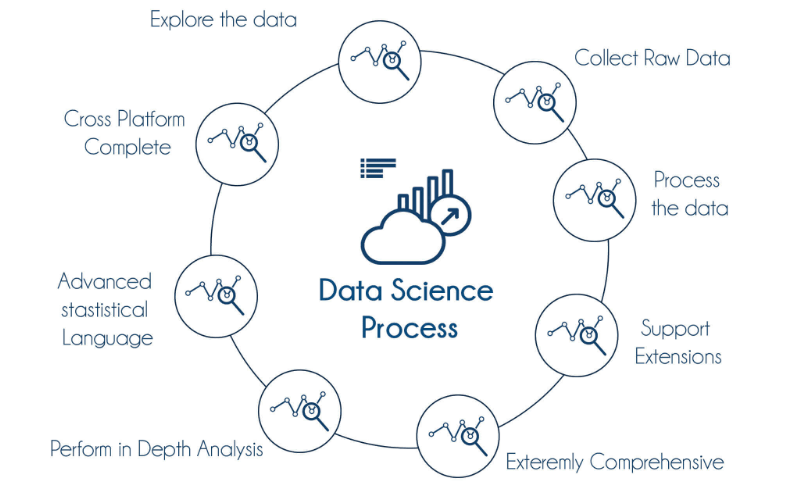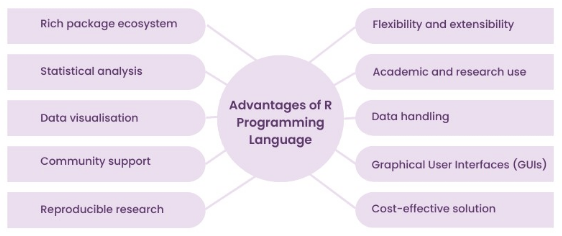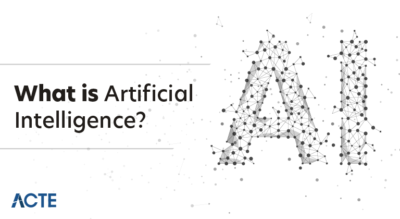
- What is R?
- Why do we use R for Data Science?
- Problem Statement for US Pollution Dataset
- Advantages of R Programming
- Disadvantages of R Programming
- Data Visualization
- R Programming Used Fields
- Conclusion
What is R?
R is a programming language appreciably evolved for Data Analytics. It is used for statistical analysis, visualization of information, and locating insights in Data Analytics. Also, R programming proves to be beneficial for developing Machine Learning models. Further, it proves to be very useful even when creating tasks on R for Data Science. R is an open-supply programming language and software program for statistical computing, information analysis, and graphical representation. It has evolved with the aid of Ross Ihaka and Robert Gentleman at the University of Auckland and is broadly utilized by statisticians, information scientists, and researchers. R offers complete tools for data manipulation, statistical modeling, and visualization, making it a popular choice in finance, healthcare, and social sciences, all of which are key areas covered in Data Science Training. It helps diverse information structures, such as vectors, matrices, lists, and information frames, and has an intensive series of applications that amplify its functionality. With its sturdy network help and integration with different programming languages, R is an effective device for coping with complicated information-pushed tasks. There are diverse applications and libraries in R that assist in creating notable visualizations of information styles. Also, numerous fields in which the packages of R for Data Science play a primary function, including the IT industry, banking and finance, media and entertainment, healthcare, and plenty more, allow us to recognize why we use R for Data Science.
Are You Interested in Learning More About Data Science? Sign Up For Our Data Science Course Training Today!
Why do we use R for Data Science?
As data science continues to grow in demand, the need for skilled data scientists has also risen, with R programming being one of the most widely used tools in data analytics. R offers over 10,000 packages that support statistical analysis, data visualization, data manipulation, exploratory data analysis (EDA), and machine learning model construction. It is a user-friendly language that allows for efficient execution of various data science tasks, making it an essential tool to Learn Data Science. R is particularly strong in solving complex real-world problems through statistical analysis and modeling. It provides customization options for libraries and applications, making it easy for developers to create tailored solutions.

Additionally, R’s ggplot2 package is widely used for high-quality data visualization. R excels at data wrangling, with built-in functions for preprocessing data. It is also highly effective in building machine learning models, offering various packages for regression, classification, and clustering. For example, when working with the US pollution dataset from the US EPA, R enables effective data manipulation, visualization, and analysis, showcasing its capabilities in real-world applications.
Problem Statement for US Pollution Dataset
- Data Source: The dataset is provided by the US Environmental Protection Agency (EPA) and spans from 2000 to 2016, covering various geographical locations across the United States.
- Missing Data: Address and handle missing or incomplete data points in the dataset to ensure accurate analysis and modeling.
- Data Visualization: Use data visualization tools (e.g., ggplot2) to create visual representations of pollutant levels over time and across different regions.
- Exploratory Data Analysis (EDA): Perform EDA to identify patterns in pollutant concentrations and explore seasonal or geographical variations, relevant to Data Science in Healthcare.
- Statistical Analysis: Apply statistical methods to assess the significance of changes in pollution levels over time and their relationship with environmental policies.
- Predictive Modeling: Build machine learning models to predict future pollution trends based on historical data, aiding in policy formulation and environmental planning.
- Objective: Analyze the US Pollution dataset to understand trends and patterns in air pollution over the years, specifically focusing on four major pollutants: ozone, carbon monoxide, nitrogen dioxide, and sulfur dioxide.
- Open Source: R is free to use, making it accessible for individuals and organizations without the need for expensive software licenses.
- Extensive Libraries: R has a vast collection of packages and libraries for various data analysis tasks, from statistical analysis to machine learning and data visualization.
- Statistical Power: R is built for advanced statistical analysis, essential in understanding the Types of Artificial Intelligence Explained Simply.
- Data Visualization: R excels in creating high-quality visualizations with packages like ggplot2 and shiny, helping users to easily interpret and present data insights.
- Flexible and Customizable: R allows for high flexibility in customizing functions, packages, and workflows to meet specific needs, providing a tailored analysis environment.
- Strong Community Support: The large, active R community contributes to constant improvements, offers a wealth of tutorials, and provides solutions to common challenges.
- Integration with Other Tools: R seamlessly integrates with other tools and languages like Python, Hadoop, and SQL, enabling effective data handling and analysis in multi-tool environments.
- Comparing Data: Data visualizations make it easier to compare different datasets or variables, highlighting correlations, differences, or anomalies.
- Data Interpretation: Data visualization helps translate complex data into clear and understandable visual formats, making it easier to identify patterns, trends, and outliers.
- Enhanced Communication: Visuals such as graphs, charts, and dashboards provide a compelling way to communicate insights to non-technical stakeholders, aiding in better decision-making.
- Identifying Trends: Through visualizations, trends over time or across categories can be quickly recognized, helping to forecast future patterns or behaviors, using Python Keywords for efficient analysis.
- Exploring Data: Interactive visualizations allow users to explore data in-depth by zooming in on specific points, filtering data, or drilling down into subsets of information.
- Storytelling with Data: Visual representations help tell a story, providing context to data and making it more engaging and memorable for the audience.
- Improved Decision-Making: By visualizing data, decision-makers can make quicker, data-driven choices, as they can easily digest and interpret key insights from visual cues.
To Explore Data Science in Depth, Check Out Our Comprehensive Data Science Course Training To Gain Insights From Our Experts!
Advantages of R Programming

Disadvantages of R Programming
Despite its many advantages, R programming has numerous hazards that can pose demanding situations for customers. One of the primary drawbacks is its steep studying curve, specifically for novices unfamiliar with programming or statistical concepts. Unlike more excellent consumer-pleasant languages, R calls for stable information on coding and record structures. Additionally, R is memory-intensive and may be inefficient while dealing with massive datasets because it processes data in memory, which might also result in performance issues, a challenge addressed in Data Science Training. Another problem is its gradual execution pace compared to languages like Python and C++, making it much less appropriate for real-time applications. R additionally has constrained assistance for dynamic and web-primarily based totally applications, making it much less potent for growing interactive software. Furthermore, even as R has a sturdy consumer community, it lacks the company backing from which a few different programming languages have an advantage, mainly due to inconsistent documentation and fragmented improvement efforts.
Gain Your Master’s Certification in Data Science by Enrolling in Our Data Science Masters Course.
Data Visualization
R Programming Used Fields
R programming is widely applied across various fields due to its powerful capabilities in data analysis, statistical computing, and visualization. In data science and machine learning, R is commonly used for data preprocessing, predictive modeling, clustering, and classification through libraries like Caret and randomForest. In statistics and research, it is utilized for hypothesis testing, regression analysis, and time-series forecasting. The finance and banking sectors rely on R for risk analysis, portfolio management, fraud detection, and financial modeling. In healthcare and bioinformatics, R plays a crucial role in analyzing clinical data, conducting epidemiological studies, genomics research, and drug discovery, highlighting its importance in understanding What is Data Science. The social sciences and psychology fields use R for behavioral data analysis, survey research, and statistical modeling. In environmental science, R is used to analyze weather data, pollutant levels, and ecological trends. Marketing and business analytics professionals leverage R for customer segmentation, sentiment analysis, sales forecasting, and campaign optimization. Lastly, government and policy analysis utilize R for financial forecasting, census data analysis, and public health research.
Want to Learn About Data Science? Explore Our Data Science Interview Questions & Answer Featuring the Most Frequently Asked Questions in Job Interviews.
Conclusion
R programming is a powerful and versatile language widely used for statistical computing, data analysis, and visualization. Its open-source nature, extensive library support, and strong community make it a popular choice for researchers, data scientists, and analysts across various industries. R excels in handling complex data manipulation tasks, creating high-quality visualizations, and implementing advanced statistical models. However, it does have some limitations, such as a steep learning curve and performance issues when dealing with large datasets, which are addressed in Data Science Training. Despite these challenges, R remains a preferred tool for data-driven decision-making due to its adaptability and continuous development. As data technology continues to advance, R will continue to play a crucial role in analytics, research, and predictive modeling, helping professionals derive meaningful insights from data and solve real-world problems effectively. Its ongoing evolution ensures it will remain a key player in the field of data science.


